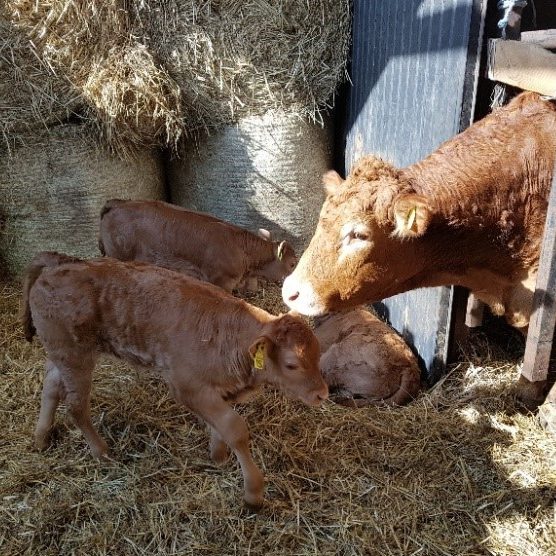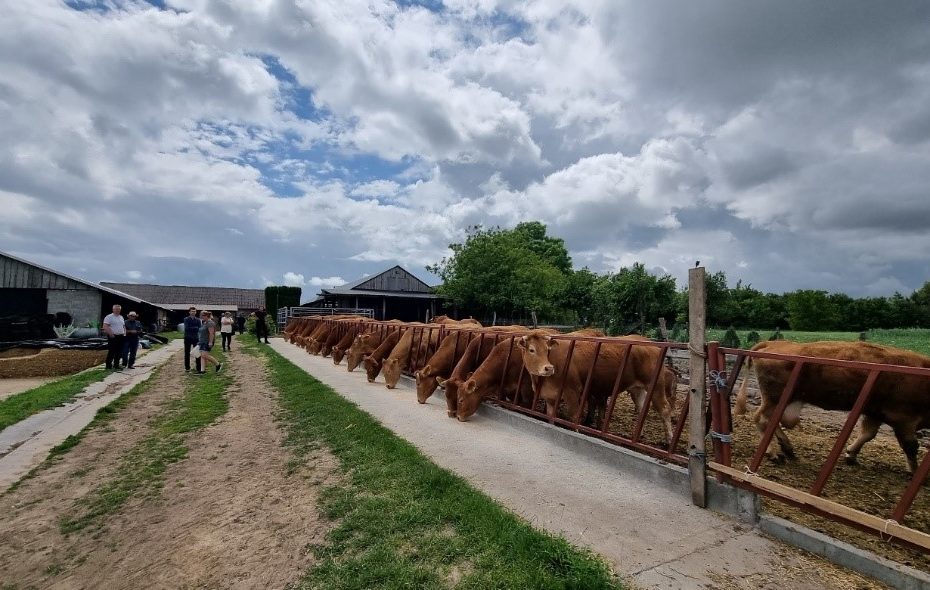Demonstration meeting of farmers – breeders from the Świętokrzyskie Voivodeship at a demonstration farm in Czarnocin, as part of sub-measure 1.2. “Support for demonstration projects and information activities” of the Rural Development Programme 2014–2020 on Modern technologies for breeding and raising beef cattle.
A visit by farmers from the Świętokrzyskie Voivodeship to a demonstration farm in Czarnocin as part of sub-measure 1.2 “Support for demonstration projects and information activities” of the Rural Development Programme 2014–2020 for “Modern technologies for breeding and raising beef cattle”. This operation is co-financed by the European Union with funds from the European Agricultural Fund for Rural Development (EAFRD).
Meetings as part of the “Demonstrations” project in Czarnocin farm, Świętokrzyskie Voivodeship, are held under the title “Effective management of a beef cattle herd based on modern methods of grassland assessment and electronic monitoring of animals”. The farm in question was selected for the project due to its model operation under conditions of limited pasture resources. The aim of the demonstration is to show the management of a beef herd in terms of rational use of existing grassland resources using a system of innovative electric mobile grazing fences. The demonstration will show how to optimize herd management, monitor thermal conditions and body temperature of the cattle both while grazing and in the paddock, as well as while the animals are housed in livestock buildings.

The family farm owned by Mikołaj Sambór is located in Czarnocin, Kazimierski County (Świętokrzyskie Voivodeship). It covers an area of approximately 27 ha, including 6 ha leased, of which 23 ha are arable land for cultivation and 3 ha of grassland, including pasture. Due to limited grassland resources, the owner plans to increase the area by 10 ha. The farm keeps Limousin cattle, 78 in total, including 31 suckler cows and 2 breeding bulls. This year, Charolais heifers have been purchased for the farm due to the planned expansion of the number of animals and breeds being reared. The herd is subject to meat performance testing by the Polish Association of Beef Cattle Breeders and Producers, being in close contact with the Association’s zootechnician-selector and breeding advisor, Ms Ewelina Udziela, and the National Research Institute of Animal Production in Balice, whose employees carry out checks on the origin of breeding animals and routinely conduct ultrasound evaluations of the meatiness of breeding bulls. The herd therefore has strict origin control and the selection of animals for breeding is based on bulls with high genetic merit from Poland or France. In addition to fattening animals, the farm sells high-value breeding bulls.




The animals are kept in the confinement/grazing system, in a free-stall litter barn in group pens, with access to the paddock and a separate grazing area about 50 metres away from the barn.
Grazing is carried out in the months of April to November, depending on the regrowth, for about 12 hours a day. Grazing may be used by all technological groups with the exception of fattening animals, which have access to a separate, hardened outside yard (paddock).
During the grazing period, the animals have permanent access to roughage, such as straw or hay, which is given in roofed feeding troughs, while the basic feeding is carried out on an outdoor feeding table. During grazing, the animals have the option of using shade or overhead shelters as protection from the sun, which significantly reduces thermal stress during the summer grazing season.
During the autumn season, the animals undergo a number of grooming procedures such as claw checks and possible trimming. It is also during this period that weaning of calves from their mothers is carried out, each such period having to be assessed by determining the weight of the animals and comparing it with the initial weight at the beginning of the grazing season. Calves stay with their mothers until they are 8 months old, after which they are weaned into a separate group according to sex, with an average body weight of 280 kg.
As mentioned above, breeding bulls and bullocks are housed in a separate building, in group pens, while calves, until the weaning period, stay with their mothers, both in the pasture and in the building; the housing is of an open-sided type. In the building for mothers with calves, a proprietary solution is used for a separate area for calves, through an openwork partition that only the calves can cross, and as part of their welfare, the suckler cows have constant visual contact with their offspring, while the calves are free to return to their mothers. At the same time, this system makes it possible to use different supplementary feeding for the calves.
It is also worth noting the additional equipment in the calf building in the form of a suspended calf play ball, which significantly improves the welfare conditions of the animals kept.
The demonstration meeting (the first one) took place on 7 June 2023. It was attended by the owner and his wife, the farm’s supervisor from the Świętokrzyskie Agricultural Advisory Centre, Mateusz Niziurski, and Dr Eng Grzegorz Skrzyński, the scientific supervisor of the farm on behalf of the National Research Institute of Animal Production. Dr Skrzyński and the supervisor from the Świętokrzyskie Agricultural Advisory Centre presented the characteristics of the farm and then the owners added additional information about the farm to the presented characteristics. As part of the demonstration, the participants listened to a lecture on breeding and raising beef cattle, and were also presented with information on the suitability of other breeds of beef cattle for culinary beef production. The audience were introduced to the most common breeds of beef cattle bred in Poland and their phenotypic and genetic characteristics predisposing them to various forms of use and fattening. Dr Skrzyński also discussed the equipment necessary for the demonstration, with which the farm in Czarnocin will be equipped.
Particular attention was paid to housing conditions and monitoring animal health, both in the pastures and barns. On the farm, great emphasis is placed on controlling the occurrence of thermal stress, which can significantly affect animal welfare and weight gain. The meeting discussed innovative monitoring solutions that are used to effectively track these parameters.
As part of the theoretical part of the training, visitors also had the opportunity to ask numerous questions about the farm itself and the training material presented. During the practical part of the demonstration, everyone went on a tour of the farm.
The “Demonstrations” project includes three visits by farmers, which take place during the normal operation of the farm throughout the grazing season. In this way, participants in the observations will be able to observe differences in the operation of the farm.
The meeting with the farmers concluded with a discussion on the profitability of rearing beef cattle, especially under conditions of small areas of grassland for grazing or roughage production, which is quite characteristic of the area around the farm, as this region is dominated by small farms, usually with vegetable or fruit production.
